- Lionel:At (5:22) on the video John Vennari says Cardinal Kaspar says that we put side by side a propostion and its opposite .So there is ambiguity.
- Really?
- For example Cardinal Kaspar and John Vennari and Louie Verrecchi Ad Gentes 7,Vatican Council II says all need faith and baptism. While Lumen Gentium 16 infers,implies,suggests for the three of them, that all do not need faith and baptism since a person can be saved in invincible ignorance.
- Here the fault is not with Vatican Council II. Since the text does not state that there are known cases saved in invincible ignorance (and without the baptism of water).It has to be inferred wrongly here. This is the conclusion of Cardinal Kasper and John Vennari and Louie Verrechio.They make a wrong inference.For me LG 16 is hypothetical and known only to God .So it cannot be an exception in 2014 to the dogma on salvation or Tradition in general. The ambiguity comes from Kaspar and the others. The text is traditional.Similalry later in the video John Vennari and Louie Verrecchio will assume that UR 3 is an exception to traditiion.Here is another example, to show how the reasoning is wrong:Lumen Gentium 14 says all need to enter the Church .Let us call this passage A :-A.Christ, present to us in His Body, which is the Church, is the one Mediator and the unique way of salvation. In explicit terms He Himself affirmed the necessity of faith and baptism and thereby affirmed also the necessity of the Church, for through baptism as through a door men enter the Church. -Lumen Gentium 14Now comes the part which is assumed to be visible and so an exception to what is quoted above in A.Let us call it B.B.Whosoever, therefore, knowing that the Catholic Church was made necessary by Christ, would refuse to enter or to remain in it, could not be saved.-Lumen Gentium 14Lionel: The ambiguity is created by Cardinal Kaspar since he assumes that B refers to known and visible cases in the present times. Since they are allegedly known, they would be an explicit exception to A. So he concludes all do not need to enter the Church in the present times.Behold! Vatican Council II now contradicts itself and becomes ambigous. He uses the irrational inference and the Council is a a break with Tradition.Without the inference the Council here is traditional.There are no exceptions to A.Here is another passage, in which we can see the influence of Cardinal Richard Cushing and the Jesuits from Boston.Let us call this passage C. They imply here that these Catechumens are saved without the baptism of water and these cases are known to them. They are in Heaven saved without the baptism of water is the conclusion.Since they are known to them allegedly they become exceptions to the dogma on salvation and Tradition.This is false. Since these Catechumens cannot be named.C.Catechumens who, moved by the Holy Spirit, seek with explicit intention to be incorporated into the Church are by that very intention joined with her. With love and solicitude Mother Church already embraces them as her own.-Lumen Gentium 14So B and C can only contradict A if it is wrongly inferred that the dead now in Heaven, saved, are visible on earth to be exceptions to the traditional teaching on salvation. In this way Cardinal Kaspar,John Vennari and Louie Verrecchio make the Council ambigous.B and C are not a problem for me since I assume they are hypothetical cases known only to God.For Cardinal Kaspar they are not hypothetical cases.So there is a propostion A but B and C are not its opposite.They are its opposite only if you add an irrational inference i.e only if you assume that the dead who are now in Heaven and saved as mentioned in LG 16,UR 3 etc , are visible and known on earth in 2014 to be explicit exceptions to all needing to enter the Church with ‘faith and baptism’ for salvation.This is a subtle error and is the cause of the confusion and ambiguity in Vatican Council II.
- -Lionel Andrades
- http://www.harvestingthefruit.com/fcchicago/#comment-27053
Saturday, November 8, 2014
Bruciati vivi perché cristiani
http://www.famigliacristiana.it/articolo/bruciati-vivi-perche-cristiani.aspx
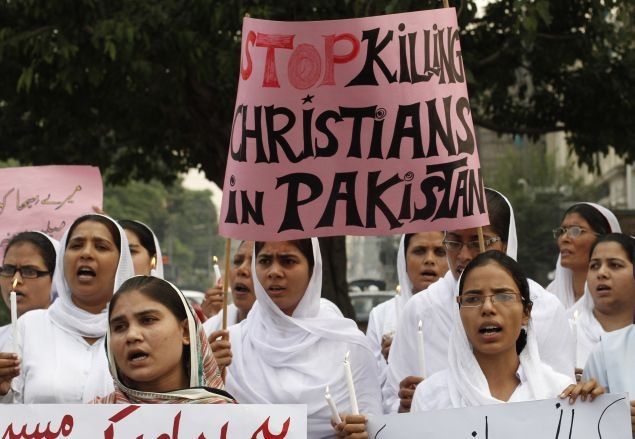

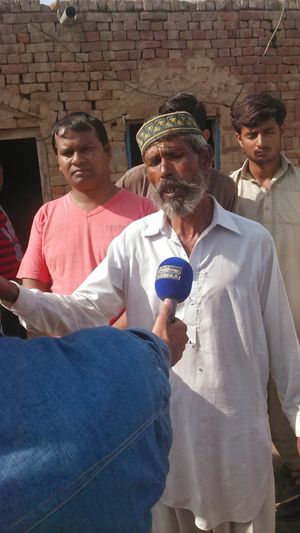
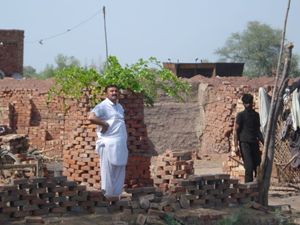
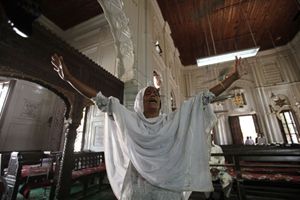
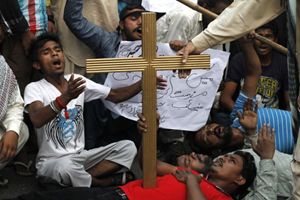

06/11/2014 Shahzad Masih e Shama Bibi (26 e 24 anni) avevano quattro figli. La donna era incinta. Sono stati accusati di blasfemia: almeno 400 persone li hanno sequestrati, percossi e gettati nella fornace per mattoni. Sdegno e denunce.

“Una barbarie, un atto disumano che resterà scolpito a lettere di fuoco nella storia del Pakistan”: l’avvocato cristiano Mushtaq Gill è ancora sotto shock per il tragico episodio avvenuto in un piccolo villaggio del distretto di Kasur, a Sud di Lahore, la capitale del Punjab pakistano. Il 4 novembre, due coniugi cristiani, Shahzad Masih e Shama Bibi (26 e 24 anni) sono stati sequestrati, torturati e arsi vivi da un folla di musulmani che li accusavano di aver bruciato pagine del Corano, dunque di aver commesso un imperdonabile atto di blasfemia. L’avvocato Gill, impegnato a difendere molti cristiani pakistani, vittime di false accuse e ingiusti processi – fa parte anche del pool di legali che ha difeso il noto caso di Asia Bibi – è stato uno dei primi testimoni oculari dell’accaduto. Convocato da alcuni cristiani del luogo, in men che non si dica si è recato ieri stesso sul posto, ad ascoltare direttamente con i presenti, a parlamentare con la polizia locale, a portare la solidarietà concreta alle famiglie dei due coniugi, affrante e annichilite.

Nel dettagliato racconto reso a Famiglia Cristiana, Gill ricostruisce la vicenda: “Domenica scorsa, 2 novembre, è deceduto Nazar Masih, padre di Shahzad. Shama, ripulendo l’abitazione dell’uomo, aveva preso alcuni oggetti personali, carte e fogli del defunto, ritenuti inservibili, facendone un piccolo falò. Secondo un uomo musulmano che ha assistito alla scena, in quel rogo vi sarebbero state delle pagine del Corano. L’uomo ha quindi sparso la voce nei villaggi circostanti e una folla di oltre 100 persone ha preso in ostaggio i due giovani, tenendoli per due giorni in un stanza della fabbrica di mattoni dove lavoravano e torturandoli”. Intanto, prosegue Gill, nella moschee dei villaggi si diffondeva l’appello contro i due blasfemi. La mattina del 4, il tragico epilogo. “Oltre 400 musulmani inferociti, sull’onda dell’emotività religiosa istigata dai leader locali, hanno preso i due giovani, li hanno colpiti con violenza, fratturando loro gambe e braccia. Poi li hanno spinti nella fornace usata per cuocere i mattoni di argilla”.

Un'immagine di una fornace per mattoni in Pakistan.
Tardivo l’intervento della polizia e delle autorità. Avvisati da altri cristiani, gli agenti hanno solo constatato il decesso e fermato , per un primo interrogatorio, oltre 40 persone, incluso il proprietario della fabbrica. Mentre il primo ministro del Punjab, Shahbaz Sharif ha creato una speciale commissione per indagare rapidamente sui fatti e procedere a formalizzare accuse e arresti. Lo sdegno e l’amarezza è alle stelle: “E’ un crimine che dimostra quanto sia aumentata in Pakistan l'insicurezza dei cristiani. Una semplice accusa è sufficiente per essere vittime di esecuzioni extragiudiziali. Vedremo se qualcuno sarà punito per questo omicidio”, nota Gill.

Cristiani in Pakistan: una minoranza perseguitata. Foto Reuters.
Tra i sacerdoti cattolici che oggi si sono recati personalmente in loco, vi è il domenicano James Channan, Direttore del “Peace Center” di Lahore, centro studi impegnato nel dialogo interreligioso. Per lui “l’orribile esecuzione offende la giustizia, i diritti umani, la dignità umana, la civiltà, ed è contrario allo stato di diritto”, ha detto all’agenzia vaticana Fides. Per questo oggi a Lahore organizzazioni cristiane e gruppi della società civile hanno manifestato per la giustizia, per la legalità e per il rispetto dei diritti umani. I dimostranti chiedono un intervento di una apposita commissione Onu per compiere un esame obiettivo sulla legge di blasfemia, sulla sua strumentalizzazione e sulle conseguenze. “Se questa legge non sarà fermata e corretta, vi saranno altri incidenti e tragedie come questa”, ammonisce padre Channan. Concorda su questo punto Amnesty International che, invitando le autorità pakistane ad “assicurare alla giustizia i responsabili dell'uccisione della coppia cristiana accusata di blasfemia”, definisce l’omicidio “solo l'ultima manifestazione della violenza che chiunque può subire in Pakistan dopo un'accusa di blasfemia”.

Cristiani in Pakistan: una minoranza perseguitata. Foto Reuters.
Secondo Amnesty, “le leggi sulla blasfemia violano le norme del diritto internazionale e i diritti umani e devono essere riformate con urgenza, provvedendo a una efficace salvaguardia contro il loro abuso, fino a una eventuale abrogazione”.L’Ong domanda al governo di Islamabad di “affrontare la violenza compiuta in nome della religione” senza garantire l’impunità ai colpevoli. Una “inchiesta imparziale”, ma nessuna citazione della famigerata “legge nera”, invece, nelle parole del Consiglio degli Ulema del Pakistan. Muhammad Tahir Ashrafi, presidente del Consiglio, condanna la violenza, esprimendo “profondo dolore per l'incidente”,ma scarica le responsabilità “sulla negligenza della polizia”. Gli ulema hanno comunque formato un apposito comitato che intende contribuire a “portare alla luce i fatti”.
I genitori di questo bambino pakistano sono stati bruciati vivi. Erano cristiani. Chi lo aiuterà?
I genitori di questo bambino pakistano sono stati bruciati vivi. Erano cristiani. Chi lo aiuterà?
Il sito cattolico Aleteia.org dopo il martirio dei due Genitori pakistani Shahzad Masih e Shama Bibi (26 e 24 anni) bruciati in una fornace perché cristiani, ha lanciato su Facebook un appello per tutti: credenti e laici.
“I genitori di questo bambino pakistano sono stati bruciati vivi.
Erano cristiani.
Chi farà delle campagne per loro?”
Dopo il martirio dei due genitori cristiani un Seminarista Cattolico pakistano ci ha mandato questo messaggio :
" Pray for paksitani christian : 3 days ago Christian couple burnt alive in brick kiln by muslims mob with allegation of blasphemy.
Pray for us. some political parties warn ISIS came in pakistan "
Pregate per i Cristiani in Pakistan : 3 Giorni fa una coppia cristiana è stata bruciata viva nella fornace dai musulmani con l'accusa di blasfemia.
Prega per noi.
Alcuni partiti politici avvertono che l' ISIS è venuto in Pakistan
Bishop Athanasius Schneider makes the same error as John Vennari and Louie Verrechio
S.Armaticus
Crying heresy – Bishop Athanasius cries even worse than this
Lionel:
Bishop Athanasius Schneider makes the same error as John Vennari and Louie Verrechio in the video above.
Bishop Schneider has called for a Syllabus of Errors on Vatican Council II.He is not aware that there can be two ways of interpreting UR 3, for example, and the rest of Vatican Council II.
He assumes UR 3 refers to known cases in the present times who are a break with Tradition.The visible- dead.
For me UR 3 refers to a possibility known only to God.It is a hypothethical case. So it is not an exception to Tradition ( extra ecclesiam nulla salus, Catechism of Pope Pius X etc).
He uses an irrational premise, as do John Vennari and Louie Verrechio, in the interpretation of UR 3 ( and also NA 2,LG 16, LG 8 etc).
I do not add a premise in the interpretation of UR 3, NA 2, LG 16,LG 8 etc.
So for me Vatican Council II is not a break with extra ecclesiam nulla salus and the traditional teaching on other religions and Christian communities.
Bishop Schneider’s interpretation of Vatican Council II is heretical, non traditional and irrational. He is not aware that the premise he uses , comes from the Letter of the Holy Office 1949 which is responsible for all this confusion.
According to Ad Gentes 7 all need ‘faith and baptism’ for salvation.All signifies there are no know exceptions in 2014. There are no known exceptions mentioned in Vatican Council II. LG 16,UR 3 cannot be an exception since humanly we cannot see people who are now in Heaven.
Ad Gentes 7 is saying all Jews, Muslims and other non Catholics are on the way to Hell since they do not have Catholic Faith and the baptism of water. It is saying that the Prophet Mohammad needed faith and baptism for salvation.He did not have it.
If liberals wrongly say that only those who know about Jesus and the Church and yet do not enter are damned (LG 14) (and imply that we can know these cases in 2014 for them to be exceptions) then it must be noted that the Quran indicates that the Prophet Mohammed knew about Jesus and the Church and yet chose to found another religion.In this religion they take his name when they pray and circle a big stone believing their sins are forgiven.
Ad Gentes 7 indicates, all the members of the B’Nai Brith are on the way to Hell without faith and baptism. They are educated and are aware of Jesus and the Church and yet do not enter.
Most people do not have faith and baptism at the time of death. Jesus says the way to Heaven is narrow and the way to Hell is wide and most people take it. Most people die without the baptism of water( John 3:5, Mk.16:16), without the Sacrament of Confession and with mortal sin on their soul.
This is the official teaching of the Catholic Church in Vatican Council II and after Vatican Council II and it is not just a personal opinion. I am quoting you Church text in Vatican Council II which affirms Tradition and which is still ignored by Bishop Athanasius Schnieder, John Vennari and Louie Verrecchio.-Lionel Andrades
If liberals wrongly say that only those who know about Jesus and the Church and yet do not enter are damned (LG 14) (and imply that we can know these cases in 2014 for them to be exceptions) then it must be noted that the Quran indicates that the Prophet Mohammed knew about Jesus and the Church and yet chose to found another religion.In this religion they take his name when they pray and circle a big stone believing their sins are forgiven.
Ad Gentes 7 indicates, all the members of the B’Nai Brith are on the way to Hell without faith and baptism. They are educated and are aware of Jesus and the Church and yet do not enter.
Most people do not have faith and baptism at the time of death. Jesus says the way to Heaven is narrow and the way to Hell is wide and most people take it. Most people die without the baptism of water( John 3:5, Mk.16:16), without the Sacrament of Confession and with mortal sin on their soul.
This is the official teaching of the Catholic Church in Vatican Council II and after Vatican Council II and it is not just a personal opinion. I am quoting you Church text in Vatican Council II which affirms Tradition and which is still ignored by Bishop Athanasius Schnieder, John Vennari and Louie Verrecchio.-Lionel Andrades

No one from the SSPX to defend John Vennari and Louie Verrecchio http://eucharistandmission.blogspot.it/2014/11/no-one-from-sspx-to-defend-john-vennari.html
The Paramagisterium
The Catholic Church is infallible. Her infallibility is supremely invested in the Roman Pontiff, but is also exercised by the college of bishops, when they universally teach the same doctrine with and under the pope.
Not only books, but libraries of books have been written to explain the truths expressed in those two sentences, there being myriad complexities surrounding an issue that is, at its heart, quite simple.
One undeniable hallmark of Catholic dogma has always been itsclarity. The Church, as a good teacher, does not guide her children in halting speech. She is not vague or ambiguous. Indeed, to teach infallibly and thus bind the faithful under pain of grievous sin would absolutely require clarity. Since it is manifestly contrary to reason for a teacher to demand assent of the intellect to something ambiguous or vague, how can Christ’s faithful be bound in conscience to believe something ephemeral or given to a multiplicity of contrary interpretations?
The infallible magisterium of the Catholic Church is limited in its exercise, clearly recognizable when invoked, andserious in its expression. But these marks of Catholicity are all but lost in our day when a “paramagisterium” operates seemingly to supplant the authentic magisterium of the Church.
These thoughts came to mind upon hearing the news that Libreria Editrice Vaticana has published the book, Interviste e conversazioni con i giornalisti (“Interviews and Conversations with Journalists”), a collection of interviews with Pope Francis.
Readers will no doubt recall the brouhaha that resulted from the Pope’s interviews and correspondences with Eugenio Scalfari, the atheist founder of the liberal secularist newspaper, La Repubblica. According to the Italian Catholic journalist, Antonio Socci, those very interviews are contained in the new volume.
We are soon to see an awful lot of spin.
What will likely be lost in the drama of it all is doctrinal clarity. A papal interview is not a vehicle for infallible teaching. True enough, when the Holy Father professes perennial teachings of the Faith in such a context, those dogmas are infallibly true, but that is not the point. The world is not going to consider it newsworthy that the 266th pope of the Catholic Church has reaffirmed belief in the Trinity or the Immaculate Conception. To be blunt about it, the sound bites the world is looking for, concern the hot-button questions, mostly on the subject of sexual libertinism, but also on how far the Church is willing to go in accepting other aspects of the dominant liberalism of secular society.
This drama will no doubt get very ugly. We must pray that God will work a greater good out of the confusion — e.g., that stable and orthodox theological thinkers would enlighten the confused but good-willed with some clarity about the Church’s magisterium.
(Some efforts of my own may be found in a talk I gave in 2007 entitled,“The Magisterium on the Magisterium,” and in sections of a longer work I’ve written online here and here. Thoughts on the related subject of development of doctrine may be found here and here.)
For purposes of illustration, I would like now to consider a concrete subject upon which the paramagisterium has spoken frequently and loudly, even to the point of confusing some very good Catholics —especially champions for the pro-life cause. I speak of capital punishment.
Writing for Crisis Magazine some time ago, Christopher A. Ferrara asked the question “Can the Church Ban Capital Punishment?” He replied in the negative for very weighty reasons. In brief, the entire tradition of the Church advanced and defended the right of the State to administer the death penalty, not only as a means to protect the citizenry from a repeat offense, but also for reasons of justice, deterrence, expiation, and even the spiritual welfare of the guilty, whose frightful sentence could lead to his conversion, as it did over the years for many of the condemned.
Ferrara quotes the Catechism of the Council of Trent:
Again, this prohibition [of killing] does not apply to the civil magistrate, to whom is entrusted the power of life and death, by the legal and judicious exercise of which he punishes the guilty and protects the innocent. The use of the civil sword, when wielded by the hand of justice, far from involving the crime of murder, is an act of paramount obedience to this commandment which prohibits murder. The end of the commandment is the preservation and sanctity of human life, and to the attainment of this end, the punishments inflicted by the civil magistrate, who is the legitimate avenger of crime, naturally tend, giving security to life by repressing outrage and violence.
Citing Pope Pius XII and Romano Amerio, Ferrara puts emphasis on the expiatory value of the sentence:
It must not be forgotten that the death penalty, like any criminal penalty, serves as a form of expiation. That is why prisons were once called penitentiaries. As Saint Thomas observes in the Summa: “Even death inflicted as a punishment for crimes takes away the whole punishment for those crimes in the next life, or at least part of that punishment, according to the quantities of guilt, resignation, and contrition; but a natural death does not.” (Cf. Romano AmerioIota Unum, 435). Further, in the case of capital punishment the expiatory penalty reflects the sin of one whose grave crime has caused him to lose the right to life. Some 700 years after the Summa, Pope Pius XII repeated the constant teaching of the Church in this regard: “Even when it is a question of someone condemned to death, the state does not dispose of an individual’s right to life. It is then the task of public authority to deprive the condemned man of the good of life, in expiation of his fault, after he has already deprived himself of the right to life by his crime.” (AAS, 1952, pp. 779 et. seq)
What a lot of Catholics probably do not know is that Vatican City State and the other Papal States themselves formerly used the death penalty.
In the nineteenth century, there existed in Rome the archconfraternity of San Giovanni Decollato (“Saint John Beheaded”), whose members did penance for those we now call death-row inmates. For them, part of being Christian also meant looking out for the spiritual welfare of the condemned. The Papal States were quite interested in man’s supernatural end, too. For this reason, execution days in Rome were days of prayer and penance. Saint Vincent Pallotti used to work with the archconfraternity of San Giovanni Decollato, and never complained that the popes, one of whom was Blessed Pio Nono, were “violating human dignity.”
There are some who oppose capital punishment purely for prudential reasons, and in the present context. They believe that the modern state is so evil, so given to usurp rights that are not its own, and so callous towards human life in general (e.g., abortion), that it ought not to wield the sword. This position is not at variance with Church teaching, but it is certainly debatable.
Granted, the State does not have to resort to capital punishment. The question is may it do so. And the answer is yes.
But there is a new body of teaching today, part of the paramagisterium, which has it that the death penalty is an intrinsic violation of the dignity of the human person. We hear it from bishops, priests, and pious lay faithful engaged in the pro-life movement. The logical question presents itself: If this is so, why did Christ’s infallible Church, for the entirety of her history, teach and act otherwise until the late twentieth century? This cannot be justified as a legitimate “development of doctrine,” because these individuals negate capital punishment in principle and based upon fundamental anthropological truths that the Church has either not known or overlooked until the ascendancy ofpersonalist philosophy in the twentieth century.
Capital punishment is but one issue upon which we see confusion generated by the paramagisterium. Others would include evolution (no, it’s not a teaching of the Church!), Christ’s Social Kingship, Limbo, Biblical inerrancy, and, of course, sex. Lastly, the very nature of the Church herself, her necessity and divine constitution are constantly assailed by the paramagisterium.
* * * * * * * * * * * *
Here is a YouTube video of a sermon preached by a priest friend of Saint Benedict Center on the subject of capital punishment. It’s very good.- Brother André Marie, M.I.C.M.
Subscribe to:
Posts (Atom)




